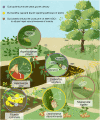The pivotal roles of gut microbiota in insect plant interactions for sustainable pest management
- PMID: 37735530
- PMCID: PMC10514296
- DOI: 10.1038/s41522-023-00435-y
The pivotal roles of gut microbiota in insect plant interactions for sustainable pest management
Abstract
The gut microbiota serves as a critical "organ" in the life cycle of animals, particularly in the intricate interplay between herbivorous pests and plants. This review summarizes the pivotal functions of the gut microbiota in mediating the insect-plant interactions, encompassing their influence on host insects, modulation of plant physiology, and regulation of the third trophic level species within the ecological network. Given these significant functions, it is plausible to harness these interactions and their underlying mechanisms to develop novel eco-friendly pest control strategies. In this context, we also outline some emerging pest control methods based on the intestinal microbiota or bacteria-mediated interactions, such as symbiont-mediated RNAi and paratransgenesis, albeit these are still in their nascent stages and confront numerous challenges. Overall, both opportunities and challenges coexist in the exploration of the intestinal microbiota-mediated interactions between insect pests and plants, which will not only enrich the fundamental knowledge of plant-insect interactions but also facilitate the development of sustainable pest control strategies.
© 2023. Springer Nature Limited.
Conflict of interest statement
The authors declare no competing interests.
Figures




Similar articles
-
The multifaceted roles of gut microbiota in insect physiology, metabolism, and environmental adaptation: implications for pest management strategies.World J Microbiol Biotechnol. 2025 Feb 27;41(3):75. doi: 10.1007/s11274-025-04288-9. World J Microbiol Biotechnol. 2025. PMID: 40011281 Review.
-
Role of gut symbionts of insect pests: A novel target for insect-pest control.Front Microbiol. 2023 Mar 13;14:1146390. doi: 10.3389/fmicb.2023.1146390. eCollection 2023. Front Microbiol. 2023. PMID: 36992933 Free PMC article. Review.
-
Advancements in the Impact of Insect Gut Microbiota on Host Feeding Behaviors.Genes (Basel). 2024 Oct 14;15(10):1320. doi: 10.3390/genes15101320. Genes (Basel). 2024. PMID: 39457444 Free PMC article. Review.
-
A soil fungus confers plant resistance against a phytophagous insect by disrupting the symbiotic role of its gut microbiota.Proc Natl Acad Sci U S A. 2023 Mar 7;120(10):e2216922120. doi: 10.1073/pnas.2216922120. Epub 2023 Feb 27. Proc Natl Acad Sci U S A. 2023. PMID: 36848561 Free PMC article.
-
Insect pathogens as biological control agents: Back to the future.J Invertebr Pathol. 2015 Nov;132:1-41. doi: 10.1016/j.jip.2015.07.009. Epub 2015 Jul 27. J Invertebr Pathol. 2015. PMID: 26225455 Review.
Cited by
-
16S rRNA Sequencing Analysis Uncovers Dose-Dependent Cupric Chloride Effects on Silkworm Gut Microbiome Composition and Diversity.Animals (Basel). 2024 Dec 17;14(24):3634. doi: 10.3390/ani14243634. Animals (Basel). 2024. PMID: 39765538 Free PMC article.
-
Inside the Belly of the Beast: Exploring the Gut Bacterial Diversity of Gonipterus sp. n. 2.Microb Ecol. 2025 Apr 12;88(1):27. doi: 10.1007/s00248-025-02524-1. Microb Ecol. 2025. PMID: 40220189 Free PMC article.
-
Characterisation of the bacteriomes harboured by major wireworm pest species in the Canadian Prairies.Insect Mol Biol. 2025 Feb;34(1):203-217. doi: 10.1111/imb.12962. Epub 2024 Oct 9. Insect Mol Biol. 2025. PMID: 39381854 Free PMC article.
-
Gut microbiota facilitate adaptation of invasive moths to new host plants.ISME J. 2024 Jan 8;18(1):wrae031. doi: 10.1093/ismejo/wrae031. ISME J. 2024. PMID: 38423525 Free PMC article.
-
Gut microbiota diversity in a dung beetle (Catharsius molossus) across geographical variations and brood ball-mediated microbial transmission.PLoS One. 2024 Jun 21;19(6):e0304908. doi: 10.1371/journal.pone.0304908. eCollection 2024. PLoS One. 2024. PMID: 38905245 Free PMC article.
References
-
- Stork NE. How many species of insects and other terrestrial arthropods are there on earth? Annu. Rev. Entomol. 2018;63:31–45. - PubMed
-
- Deutsch CA, et al. Increase in crop losses to insect pests in a warming climate. Science. 2018;361:916–919. - PubMed
-
- Harwood JD, Parajulee MN. Global impact of biological invasions: transformation in pest management approaches. Biol. Invasions. 2010;12:2855–2856.
-
- Yang Y, Wu N, Wang C. Toxicity of the pyrethroid bifenthrin insecticide. Environ. Chem. Lett. 2018;16:1377–1391.
Publication types
MeSH terms
LinkOut - more resources
Full Text Sources

